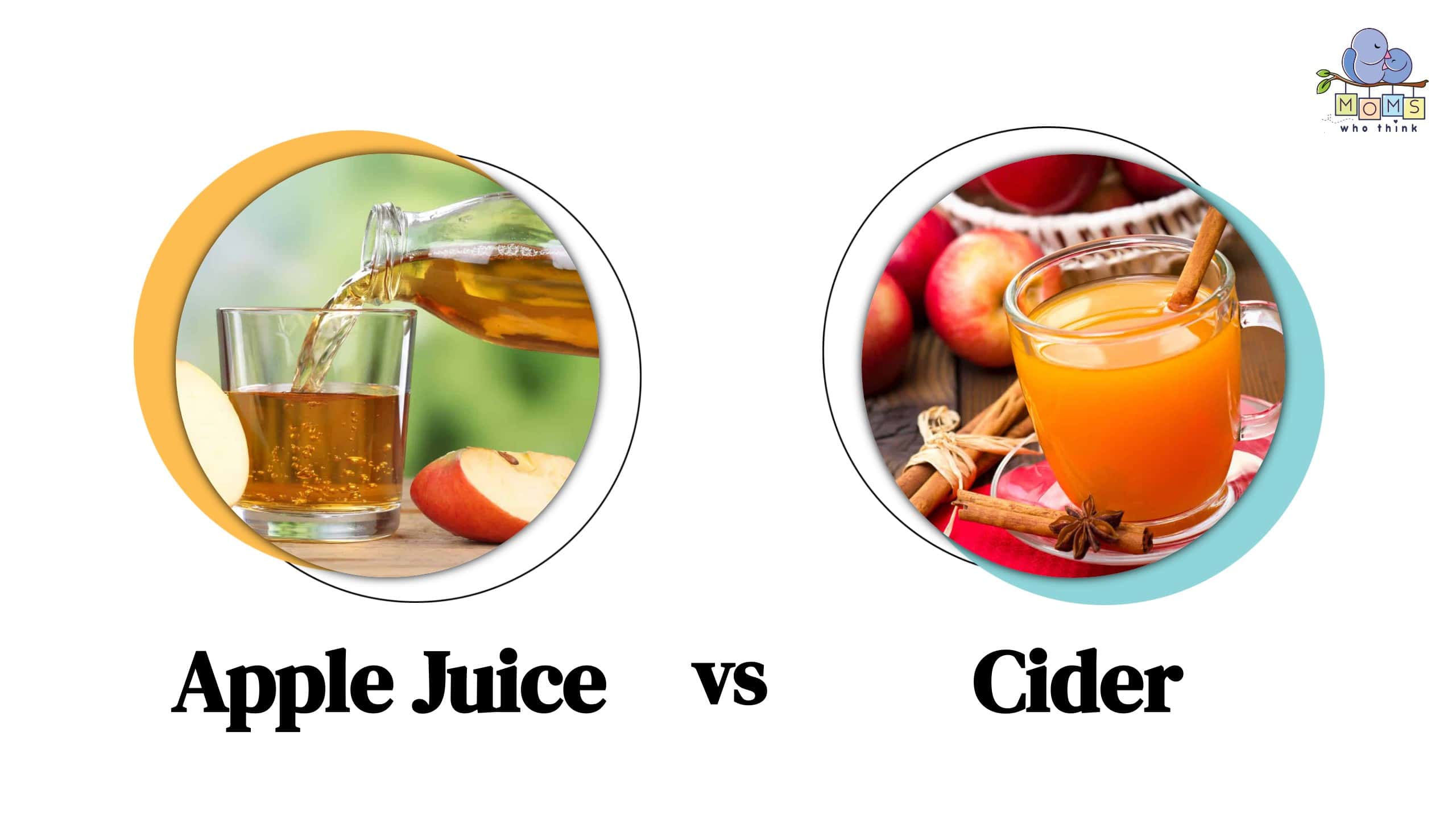In short, that depends. And while there are obvious similarities and differences, this article will show there's a LOT more to these delightful drinks than meets the eye. Especially once you understand their makeup – you will then discover which is the better option between the two for your health! But first, let’s explore the unique aspects of apple juice and cider.

Kids love apple juice!
©Batyreva Irina/Shutterstock.com
Which Came First- Apple Juice or Cider?
Did you know that for centuries apples were considered too bitter to eat? It’s true! So guess what people would do instead of just eating apples? According to the National Apple Museum, people pressed the juice from the apples and allowed it to ferment – until it built up its alcoholic content – and became a hard cider. In fact, the first Romans that sailed to the British Isles in 55 B.C. introduced the production of this fermented hard cider. Eventually, the popularity of this fermented hard cider spread throughout Europe and the Mediterranean, becoming a beloved drink among locals.
Fast-Forward to America
The early colonists introduced cider to the Americas, but found that brewing it was not simple due to challenges in growing necessary grains and barley. Fortunately, apples were easier to cultivate in New England, which led to the widespread popularity of cider across the United States.
In fact, early settlers believed it was safer and healthier to drink than water. Why? Because during the 18th and early 19th centuries, water often contained dangerous bacteria. And the alcohol in cider killed bacteria; So cider soon became the common beverage in American homesteads. Even children drank it – watered down of course – with their meals. Even America’s most famous tree farmer John Chapman, more commonly known as “Johnny Appleseed” helped play a huge role in bringing not just apples but hard cider across the country. His seeds produced the best apples for making hard cider. Why? Because they were small with a bitter taste. But then in 1920…
Cider Prohibited
The American government passed a rule called “Prohibition” that said no one could make or sell alcohol. This included hard cider even though it only contained a little bit of alcohol. It lasted from 1920 to 1933. But because of this rule, many people stopped making hard cider, and some apple trees were cut down because they were used to make the cider. This means that orchards were no longer in demand.
And by the time the rule ended, people didn't drink as much hard cider anymore. They preferred other drinks instead. Likely this was around the same time apple juice gained appeal. And so by the 1950s and 1960s, apple juice became a common choice for families, and its popularity has continued to grow ever since.
Two Kinds of Apple Juice
Apple juice is made by pressing or crushing fresh apples, extracting their natural liquid goodness. And it’s a favorite for kids and adults. It’s like you just get enough of it. That’s why when you walk into your local grocery store, you find the juice aisle has a variety of apple juices including sweet, tart, or a combination of apple types. But there are just two types of juice apples produce. For example…
Clear Apple Juice: This is apple juice that is filtered to remove pulp and solids. The juice has a clear and transparent appearance. The flavor is milder and the texture is super smooth.
Cloudy or Unfiltered Apple Juice: This kind of apple juice contains the natural pulp and sediment from the crushed apples. So, it has a slightly thicker texture and a stronger flavor compared to clear apple juice. It also has a cloudy or opaque appearance because of the apple solids in the juice.
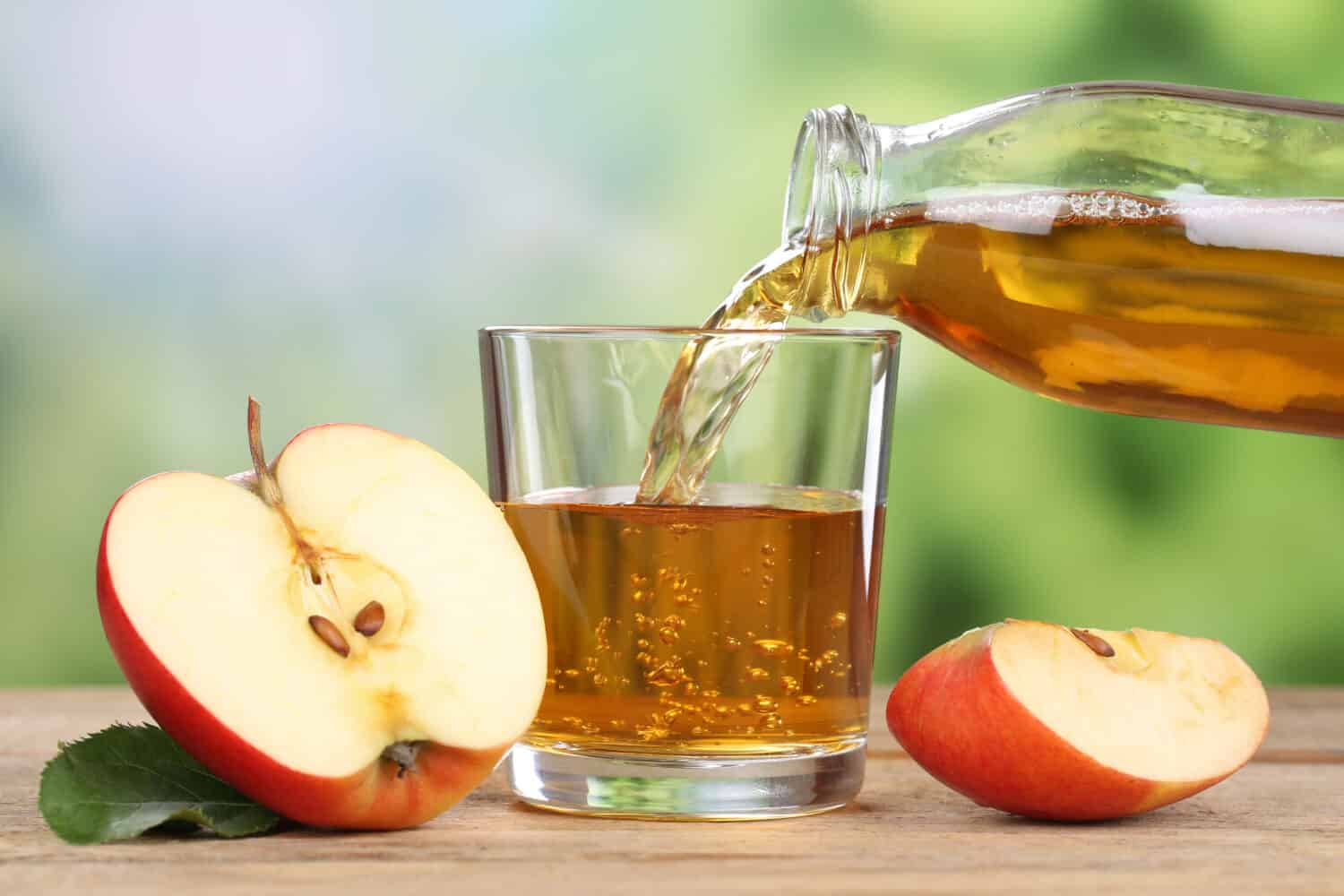
Store-bought apple juice is pasteurized to kill harmful bacteria
©Markus Mainka/Shutterstock.com
What About Today’s Cider?
Just like apple juice – starts with juicy apples. But here's where the magic happens – the natural sugars in the apple juice are allowed to ferment, creating a fizzy and sometimes alcoholic drink. It's like apple juice's rebellious side!
Today there are usually two types of cider, hard and soft.
Hard cider can have different levels of sweetness, and some even boast a touch of spice or a hint of oak. But this one's for the grown-ups!
Soft Cider is non-alcoholic. It still has that rich apple flavor and is perfect for everyone in the family, including the little ones! Some soft ciders might have a bit of natural sediment, which just adds to the fun. Especially in the fall when hot cider drinks are a cozy family favorite!
Bottom line: While apple juice charms us with its pure apple essence, cider is the flavor explorer in the family. Think about it: hard cider can be sweet or dry, fruity or tangy, and even a bit spicy. Every sip is like taking a bite out of a crisp autumn apple, but with a twist of surprise. Soft cider, on the other hand, keeps things simple and classic, delivering that unmistakable apple taste.
So now let’s talk about the…
Healthy Breakdown of Apple Juice vs. Cider
Here’s a sample of the nutritional content of an 8-ounce (240 ml) glass of store-bought apple juice vs. apple cider:
Apple Juice:
Heated to 190 degrees Fahrenheit during processing for pasteurization or to kill bacteria.
Calories: Around 119 calories.
Protein: 0 grams
Sugar: 25 grams of natural sugars (Note: Some commercial apple juices may have added sugars, which can increase the sugar content)
Carbohydrates: 26 grams
Fiber: 0 grams
Nutrients: Contains vitamin C, but may have slightly fewer nutrients compared to apple cider due to processing.
Apple Cider:
May or may not be pasteurized.
Calories: Around 110-120 calories.
Protein: 0.3 grams
Sugar: 24-28 grams of natural sugars (Note: Some commercial apple juices may have added sugars, which can increase the sugar content)
Carbohydrates: 28 grams
Fiber: 0.5 grams
Nutrients: Provides vitamins and minerals, such as vitamins A and C, potassium calcium and iron. According to WebMD, the apple pulp contains polyphenols that act as antioxidants to help fight against cell damage and reduce inflammation in the body.
Bottom line: Apple cider has slightly more nutrients compared to apple cider. However, it can be of concern since cider is usually not pasteurized to kill harmful bacteria. This isn’t to say all cider is dangerous. In fact, for most people who have a healthy immune system, apple cider doesn't present a problem. However, if you have a weakened immune system, it can be risky for you. Or if you have a vulnerable immune system such as the elderly, pregnant women, infants or children, then apple cider may pose a risk.
So, does this mean apple cider is a no go? Not necessarily. The Food and Drug Administration (FDA) recommends boiling the cider to kill any bacteria.
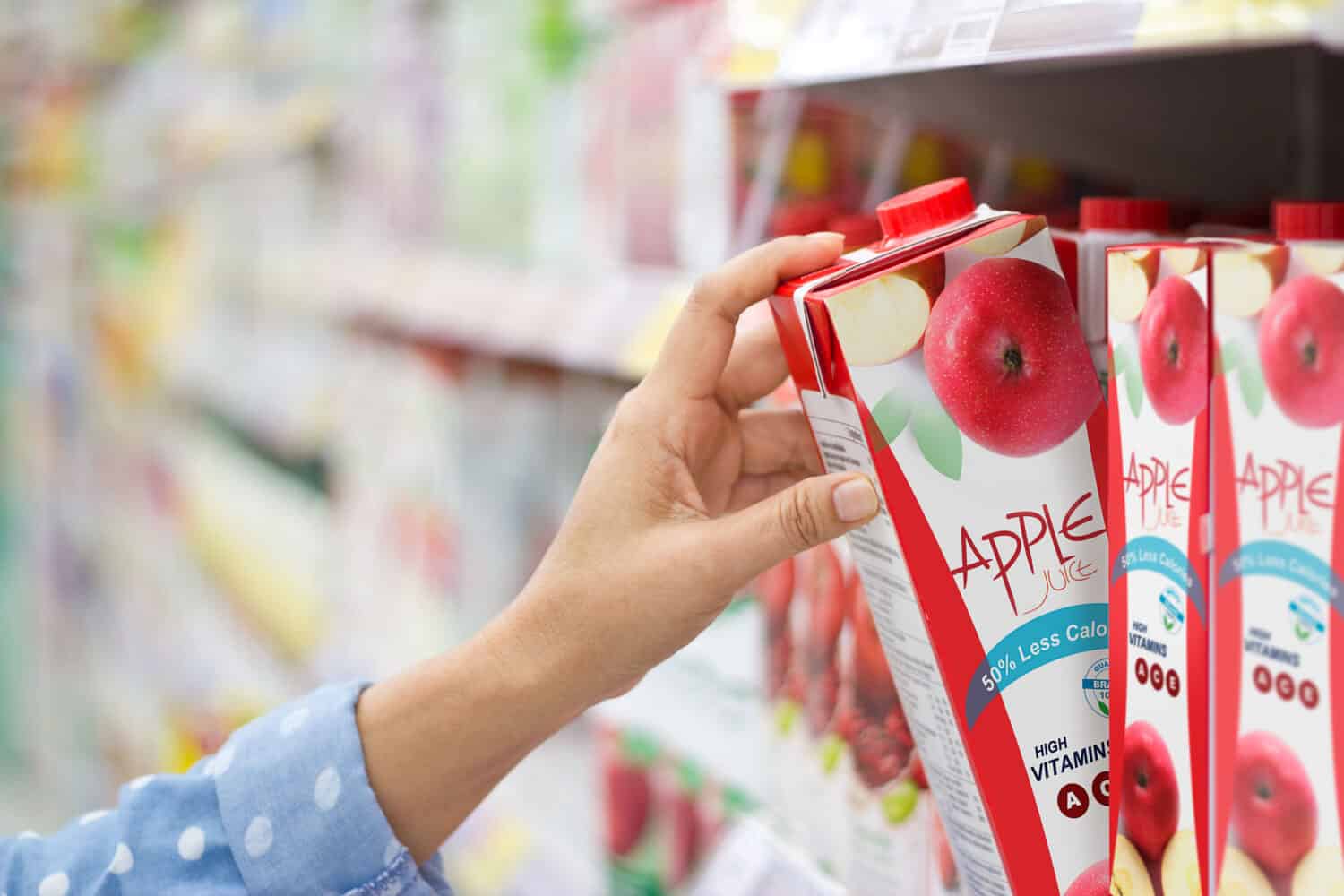
Check the labels to see if there are added sugars
©PopTika/Shutterstock.com
Read the Labels
Some places call apple juice “cider,” while others use “cider” exclusively for hard or alcoholic versions. So it’s important to check the labels. That way you know exactly what you're getting – whether it's a kid-friendly refreshing apple drink or a fizzy one for grown-ups only.
In Conclusion
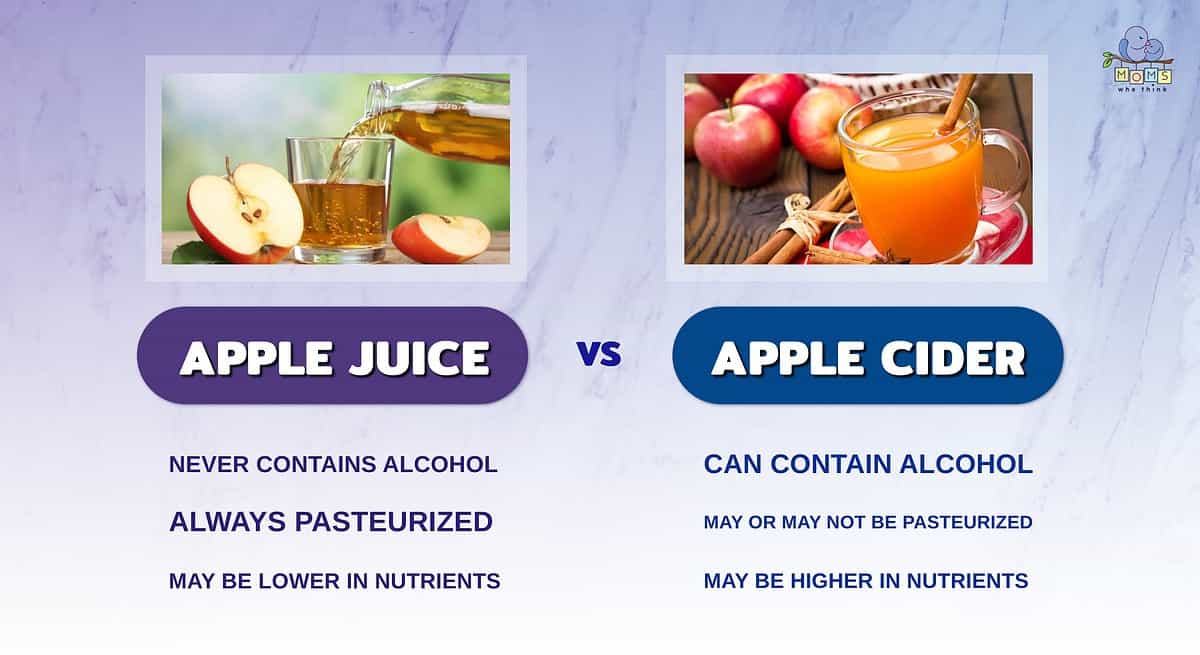
- Apple juice will never contain alcohol, meaning it's always family-friendly! Apple cider, on the other hand, can be soft or hard. Hard apple cider has alcohol.
- Apple juice always goes through a pasteurization process. Apple cider isn't always pasteurized; for this reason, those with a compromised immune system should drink with caution.
- Since it goes through more processing, apple juice may have fewer nutrients than apple cider.
Apple juice is the everyday hero that goes well with any meal. It's a reliable companion for your little ones and a go-to mixer for mocktails. It’s pasteurized to kill any harmful bacteria. However, be careful and make sure you read the labels, so you don’t get hit with lots of added sugars which can reduce its nutritional value.
On the other hand, cider contains more nutrient-dense compounds for a healthy drink. But if you have a weakened or vulnerable immune system, make sure you follow the FDA guidelines and bring the cider to a boil before consuming. Otherwise, if your immune system is fine, then when it's time for you to unwind or enjoy a night out with friends, let the cider shine! Whether you choose to sip and chat or simply relax – it’s a like a perfect grown-up treat!
Print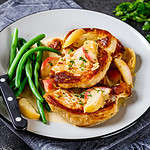
Apple Cider Pork Roast
Ingredients
- 2–3 pound pork shoulder roast
- 1 1/2 cups of apple cider
- 5–6 red potatoes, cut in half and scrubbed well
- 3 carrots, cut in 1/2 inch pieces
- 1 yellow onion, cut in 1/2 inch pieces
- 1 bay leaf
- Salt and pepper
Instructions
- Sprinkle roast with salt and pepper.
- Add roast and vegetables to slow cooker.
- Add cider and bay leaf to slow cooker.
- Cook on low for 8 hours. Remove bay leaf before serving.
